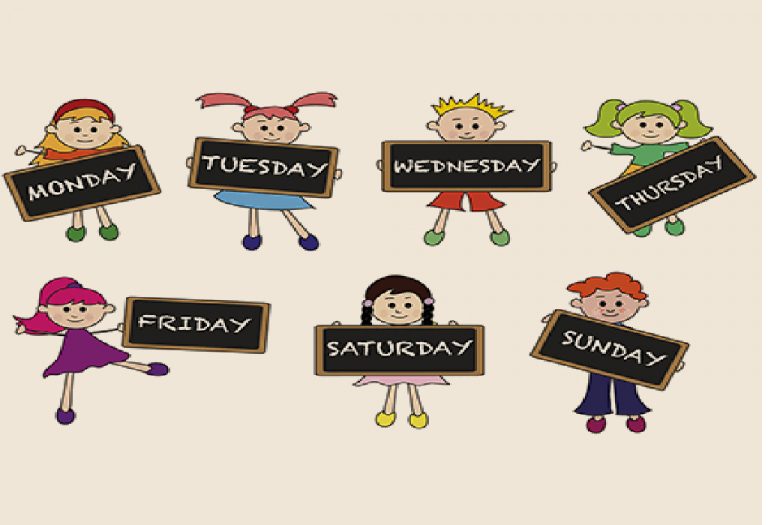Teaching Days of the Week to Children – Simple and Easy Ways
You might wonder how to teach the days of the week to kids. Learning them is through memorization, but coming up with creative activities can help greatly. You can start by repeating the names of days frequently and following up with playing a few fun games.
Teaching the days of the week to children can be quite tricky, especially if they haven’t yet started to read. To learn the days of the week, a child needs to memorise them. Once he does, he’ll find it much easier to understand the concept of time, too. The age of 3 to 4 years, when children begin to understand and comprehend things, is a good time to start teaching them about days and weeks.
What Is the Importance of Teaching Days of the Week to Children?
As children grow, they observe the people and things around them and learn. Teaching your little one the days of the week is like laying foundational learning for your little one to understand time and be included in the conversations. Moreover, learning the days of the week will support the language development of your little one, as children encounter these terms in various contexts, including songs, stories, and conversations.
When Should You Teach Days of Week to Children?
Learning the days of the week is not very difficult, and young children are like sponges, so they learn things very fast. You can start teaching them days of the week once they attain 3 to 4 years of age. This is a must activity of Kindergartners and is typically included in their curriculum.
Tips for Teaching Days of the Week to Children
Are you looking for the best way to teach days of the week to your little one? We have got some amazing ideas on how to teach days of the week to your little bunny!
1. Explain in Simple Terms
Explain to your child that there are seven days in a week. When one week is over, another one starts. You can explain that each week has five school days and two play days too. You should also explain the difference between night and day and that after every night comes a new day.
2. Tell Him the Day and His Schedule
Start your day by telling your child what day of the week it is, and what’s on his schedule for the day. For example, you can say, “It’s Monday today, and you have playgroup”, or “It’s Sunday today, and Grandpa is coming over”.
3. Break Down Yesterday, Today and Tomorrow
Teaching yesterday, today, and tomorrow to a 2-year-old is important to make him learn about the days of the week. Explain to your child that yesterday is the day before today. Name the day and connect it with an activity that he did yesterday. Do the same to explain the concept of today and tomorrow.
4. Introduce the Calendar
Show your child a calendar and point out how the days and weeks are marked on it. Show him which days his favourite festivals fall on. Show him when his birthday is and when yours and Daddy’s fall on as well.
5. Play Games
Plan interesting ‘days of the week’ games for your child. Write the days on different pieces of paper and mix them up. You can even make a ‘ days of the week’ chart for your child and schedule his activities on it using crayons and coloured pencils. Stick a few of his favourite cartoon or storybook characters to make it an even more attractive activity.
6. Make a Week Caterpillar
An engaging ‘days of the week’ activity for children is to get them to create a week caterpillar. Cut one large circle for the face and seven smaller colourful circles for the body. Write the days of the week on the smaller circle and paste them one behind the other to form the body of the caterpillar.
7. Use Poems to Teach
You can make use of poems or jingles to teach your little one day of the week in a fun way. or instance, you can create your own poem:
Mary ate eggs on Monday,
Mary ate muffins on Tuesday,
Mary ate pancakes on Wednesday,
Mary ate chocolate on Thursday,
Mary ate sandwich on Friday,
Mary ate fruits on Saturday.
And Mary slept on Sunday!
FAQs
1. Who named the days of the week?
Well, there isn’t a single person who named the days of the week; the names of the days of the week have their origins in ancient civilisations, from the Romans to the Norse. The Romans named the days after celestial bodies and gods, such as Sunday (Sun), Monday (Moon), and Saturday (Saturn). The Norse, influenced by their mythology, named the days after Norse gods and celestial bodies, which were later adapted into English. Over time, these names passed down through various cultures and languages, embracing changes little by little and shaping the modern calendar.
2. What are some tricks to help children remember the days of the week?
The tricks are aplenty! You can take the help of visual aids like YouTube videos, rhymes, card games, flashcards, puzzles, and activities to teach young ones the days of the week. You can even create a mnemonic song and have a special dance prepared for children where each week day has a special dance move, helping children remember days of the week.
3. What if my child struggles to learn the days of the week?
It is okay if your child struggles with learning the days of the week in th initial days. There is nothing to worry about; each child is unique, and they may take individual time to learn. So, be patient and keep trying with a gentle approach.
To learn the names of the days of the week, your child will have to memorize them by rote, but understanding the concept of day and night will make it easier. Repetition is the key, while fun activities that teach the days of the week to your child help him understand the concept better.
Also Read:
How to Teach Kids Alphabets?
How to Teach a Child to Share?
Teaching Young Kids About Everyday Objects
Helping Your Child Learn Name, Age and Gender
Was This Article Helpful?
Parenting is a huge responsibility, for you as a caregiver, but also for us as a parenting content platform. We understand that and take our responsibility of creating credible content seriously. FirstCry Parenting articles are written and published only after extensive research using factually sound references to deliver quality content that is accurate, validated by experts, and completely reliable. To understand how we go about creating content that is credible, read our editorial policy here.






















